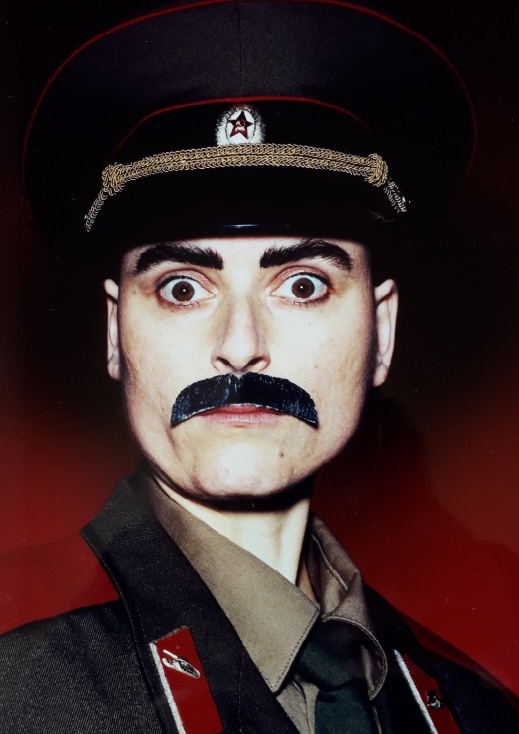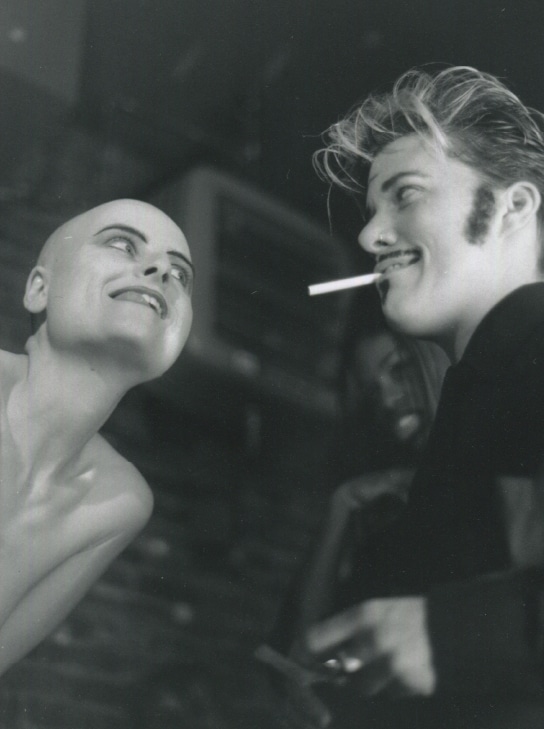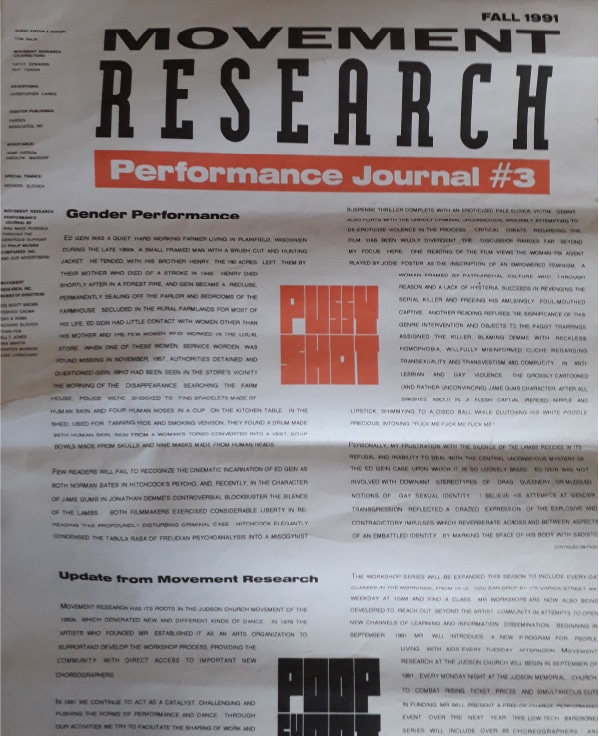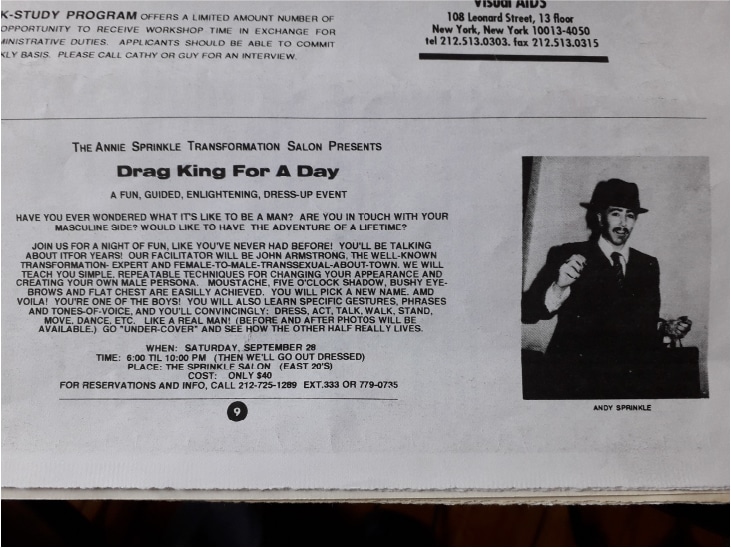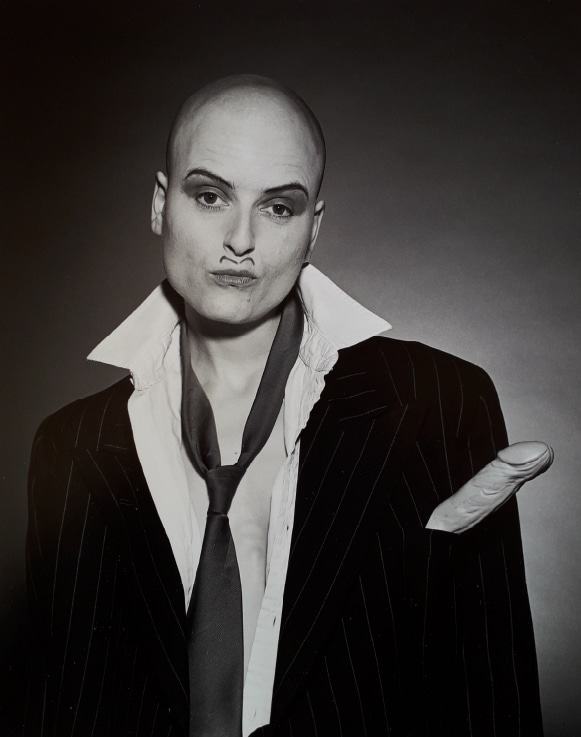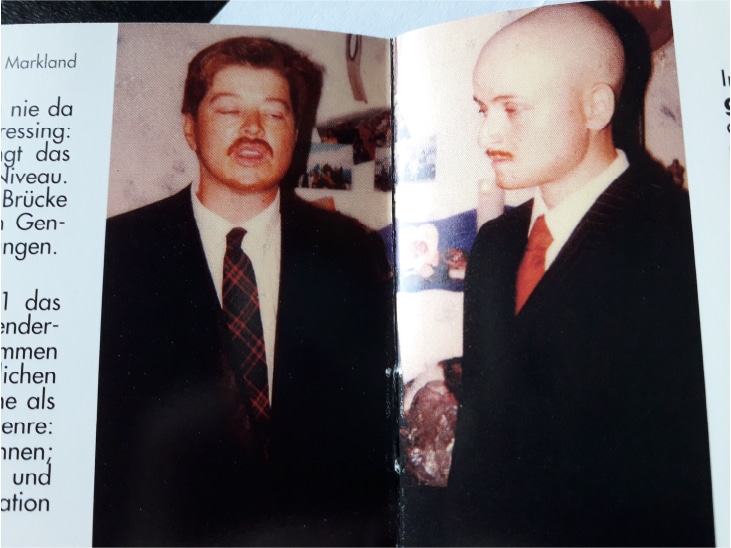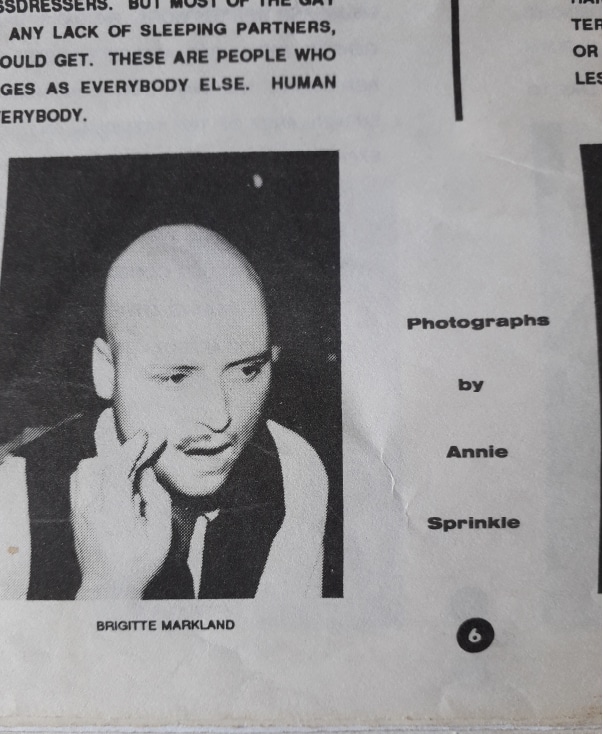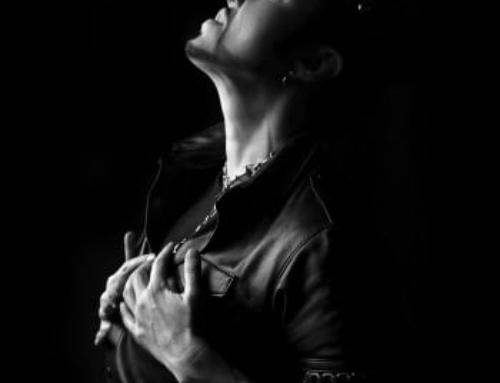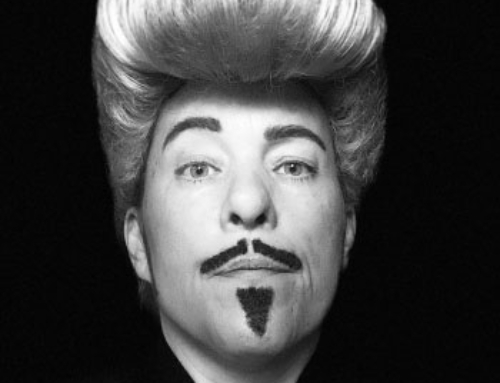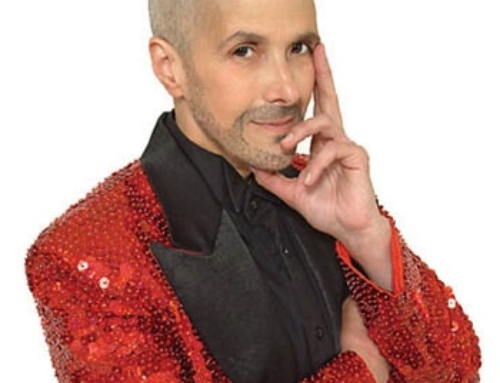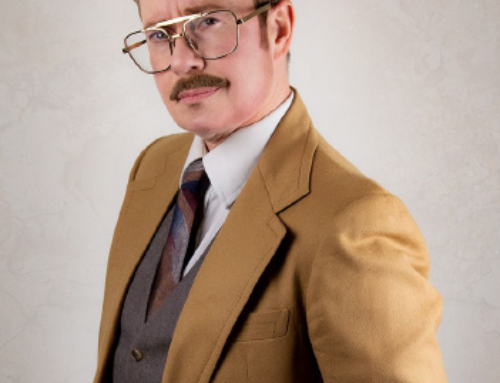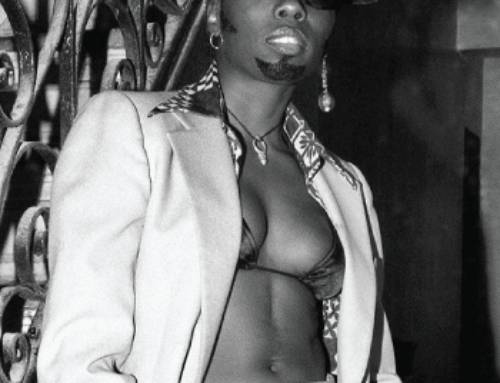
Years active
1990 – Present
Stage Name(s)
Bridge Markland
Category
Drag King
Country of Origin
Germany
Birth – Death
1961 –
Bio
The Berlin performer Bridge Markland is a virtuoso of role play and transformation. An artist who crosses boundaries between dance, theatre, drag + gender performance, cabaret + puppet theatre. Since 1985 she has been performing on theater, nightclub, and museum stages around the world. Starting in 1990 as a Drag King, Bridge became a pioneer of Drag + Gender Performance in Germany, and she has been organizing Drag King events, tours and festivals since 1994. She also works as an actress, performer, dancer and clown with other companies. Her main focus is lip-synced OneWomanShows of classical German theatre incorporating puppets and pop music. In these “classic in the box” series she presents: faust in the box (after Goethe), robbers in the box (after Schiller), and several other plays. Other shows include short drag performances: Kings + Queens as invited guests to perform along with her.
Bridge Markland was born in 1961 in West Berlin just six months before the Berlin Wall was built. As a teenager in the 1970’s, Bridge was influenced by all things Glam Rock: glitter, platform shoes, androgyny, cross dressing, and the rockstars The Sweet and David Bowie as her inspirational guides.
In 1974, Bridge made her stage debut in her school theatre company as an portly king from a Grimm’s fairy tale which foretold her Drag King career. When she was 17, Bridge saw her first drag show, the Brazilian Drag Troupe “Les Stupidas”, which proved to be a transformative experience for her. She was transfixed by seeing men in dresses lip-syncing their way through a very political and wild show. Their costumes, make-up, and movements stirred up Bridge’s desire to express herself as well. So at 17 ever the gender-bender, she asked her mom to buy her a men’s double breasted pin-striped suit which she wore with a feminine blouse and make-up.
From 1984 to 1991, Bridge performed with the dance performance company YoYo-TA. In 1985, she did her first professional performance, and performed with them all over Germany, the Netherlands and New York City. She also expanded her study to include contact improvisation and other improvisational dance + theatre forms. In 1987, YoYo-TA performed at the legendary performance space, The Knitting Factory in Manhattan, when it was just one month old. And since 1987, started to create and perform solo performances beginning with short performance pieces then moving onto longer shows
In late 1989 together with her performance partner Susanne Kukies, they began to create shows with a variety of male and female characters. Their first show premiered in early 1990 where Bridge performed two male characters and one female whereas Susanne performed two female and one male character. Bridge and the show’s director worked intensely on the physical interpretation of the male roles, emphasizing how a large, old man would wear a suit and move. Thus her character “Karl” was created. His movements became natural for Bridge and to this day “Karl” is very much alive in her performances.
Bridge started to create many different characters. This posed a problem in one early show where she would either spend a considerable amount of time in the dressing room changing looks and costumes, or it required hiring another performer to fill the time. This problem resulted in the creative solution to make the transformation from one character to the next part of the show, so the gender transformations occurred for the audiences viewing pleasure.
1990 was a pivotal, transformative year for Bridge as she began shaving her head bald. “She calls the bald head neutral where she can put any gender or creature onto it easily”. Whereas as she states, “other people perceive the bald head on a woman differently and everyone can make up their own stories.” (1)
The summers of 1991 to 1994, Bridge studied Body Mind Centering in Massachusetts, USA. During this time, she frequently visited NYC to perform on open stages and in the street, and to visit nightclubs and see shows. This is when she befriended Drag King Diane Torr who taught workshops: A Striptease Workshop and The Drag King Workshop.
The summers of 1991 to 1994, Bridge studied Body Mind Centering in Massachusetts, USA. During this time, she frequently visited NYC to perform on open stages and in the street, and to visit nightclubs and see shows. This is when she befriended Drag King Diane Torr who taught workshops: A Striptease Workshop and The Drag King Workshop. In June, 1990, Bridged attended the first Drag King Workshop which took place at Annie Sprinkle’s apartment, and was conducted by Johnny Science with Diane Torr assisting.
While in New York City, Bridge was amazed and inspired by a piece done by performance artist and Drag King Shelly Mars. She then asked Shelly to improvise a drastically funny text about how a “man” puts on a pinstriped suit becoming more powerful in the process conlfating the empowering effect of this particular piece of clothing. Bridge translated this text into German and used it’s bi-lingual version for her performance “bridgeland zwei” which premiered in 1996. The English version was called “Bridgeland” and premiered in 1994.
During the early to mid-1990’s, Bridge’s full hour, one-woman, gender-bending performances were not easily accepted in the dance scene in Germany where she was active. Her first shows were in English, then became bi-lingual German / English, using collages of text and music, lip-syncing and bilingual spoken word.
In 1994 at a small bar called ‘Ex und Pop’ in Berlin-Schöneberg, Bridge organized her first Drag King Show called: “Wir feiern Vatertag” / “We are celebrating Fathers Day” with all women on stage, men only allowed as supporting performers. This event was hugely successful. Several female performer colleagues of Bridge’s performed as Drag King’s upon Bridge’s encouragement, and continued to do so for many years.
In 1994 the German TV station ZDF asked Bridge to create a short performance out of several of her characters including: Angela the Redhead, Bridge the androgynous creature, Steve the macho guy in a pinstriped suit. This far she only had a longer performance called “Bridgeland” with these three characters, now they wanted them in three minutes. Bridge had the music edited, practised the costume changes and the performance was born. Great length for TV shows, too short for the stage, thus she created a 9 minute version in 1995, which became her biggest hit: the transformation performance: “The Most Beautiful Woman in the World”. It was performed at many venues all over the world. For many years she made a very good living from this short piece, performing in German and international TV shows, in long running Variety Shows, in theatres, museums, queer venues etc.
1996 was an active year for Bridge as her Drag King performances too off considerably. She was asked by American actor and director Rik Maverik who was living in Berlin at the time to star in a Mafia Gangster Play called: INCOGNITO from the theatre company ‘The Berlin Play Actors’. The thrill being that all the male characters were going to be played by women. The only female character which appeared only shortly, was played by Rik Maverik himself. The author of the play Richard Kuntzevich flew in from NYC to see the show and it was very successful.
Also in 1996, Bridge organized a whole “Herrenabend” / “Men’s Evening” tour in five German cities: Berlin, Munich, Düsseldorf, Hamburg, Cologne which resulted in favorable press coverage. There were two famous German magazines fighting over who will publish the story about drag kings first. The “Spiegel” (Mirror) won and the other magazine never published it, which was just as well for Bridge as they hadn’t interviewed her. After the “Spiegel” article Bridge got invited to many talk shows and cultural magazines for German TV Stations, all of them paying her well for her appearances.
And upon a visit to NYC in 1996, Bridge attended Drag King Mo B. Dick’s popular weekly Drag King party called Club Casanova. Soon after she performed there for the enthusiastic crowds and caught the attention of Swiss filmmaker Gabriel Baur who was in attendance and subsequently asked Bridge to be part of her feature documentary film: “Venus Boyz” – A Film Journey through the Universe of Female Masculinity. The international premiere was at the Berlinale Film Festival in 2002.
In 1997 together with STÜKKE Theater in Berlin Kreuzberg Bridge organized the first go drag! Festival. She created the name: go drag!, and it stuck nicely. It was a series of three different gender bending performers: Diane Torr who was living in NYC at the time with “Drag Kings & Subjects”, Tara Brandel from Ireland with “Under Wear”, Bridge Markland with “bridgeland zwei”. Each performed their show five times with high demand and all the shows were sold out.
In 1997, Bridge was asked to star in “The Rocky Horror Show” playing the role of “Frank ‘N’ Furter” at Theater Brandenburg, a small town not too far from Berlin. It was a huge success, was always sold out and even had a fan club. Eddie was also played by a woman.
In 2001 Diane Torr and Bridge Markland thought about a much larger international festival called “go drag!”. It took Bridge 5 months to write the grant application. Public funding was approved and in 2002 the festival happened at ‘Kunsthaus Tacheles’ in Berlin. The festival was one month long with an amazing programme of: full evening shows, short performance evenings, photo exhibition, film programme, workshops, party. People came from many places to watch shows and participate. Press reactions were incredible.
Since 2002, Bridge has been doing lecture performances called “king-ing the drag – drag-ing the king” on her gender performances, mostly at German and International Universities with German, English or Bi-Lingual versions available. And since 2012, she has been occasionally teaching Gender Performance Workshops.
From 2002 to 2019, Bridge worked with the Australian/German children’s Theatre Company Platypus Theater in a bi-lingual pants role as “Angstmän”. She performed as a thirteen year old boy while Bridge was 58 years old. The play was wildly successful and on occasion when the children who attended saw Bridge in public, they would shout “Theris Angstmän! (There is Angstmän!).
Bridge has also worked as a solo artist or with other companies as a dancer, performer, actor/actress, or clown since 2012. And since 2016, she has worked with Le Pustra’s Kabarett der Namenlosen, Berlin’s legendary Cabaret Show in the spirit of the 1920’s performing: Anita Berber, Valeska Gert + The Somnambulist.
In 2005, Bridge started a series of classical German Theater Pieces as full evening OneWomanShows with Pop Music and Puppets. Bridge uses the original, edited theatre text and makes a collage with snippets of popular music from different decades and centuries. She asks actors + actresses to do voice overs, then a sound engineer edits the material into an intricate collage of text and music, after a script which Bridge has created over many months of long music research. This soundtrack she learns to lip-sync and later performs most of the roles using puppets as opponents. These are 90 minute lip-sync Drag Shows of classical German Theater. Two of these shows she created English versions of: faust in the box after “Faust 1” by J.W. Goethe , robbers in the box after “The Robbers” by Friedrich Schiller. With these pieces, she did 10 tours in the US and four tours in Canada: performing at Universities and Goethe Instituts. Bridge has performed these shows in Theatres, Universities, Goethe Instituts, Libraries, High Schools, Museums, Art Institutes etc and did ten U.S. tours and four Canadian tours with them between the years 2008 – 2016. On November 25, 2021, Bridge premiered the latest piece in Berlin which is the 10th production in this series.
On February 21, 2021, Bridge was featured in the Drag King Legends Show produced by Drag Kings Mo B. Dick, Ken Vegas, Fudgie Frottage and Flare for DragKingHistory.com. This event showcased fifteen Drag King’s with 25 or more years of experience who have contributed greatly to the Drag King community and who have kept this art form going.
(Submitted by: Bridge Markland, Berlin, Germany in June 2021)

